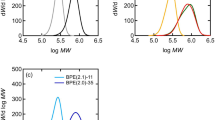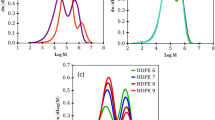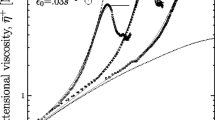Summary
The viscosity and the recoverable strain in the steady state of elongation have been measured on several polyethylenes of different molecular structures. The elongational viscosity as a function of tensile stress runs through a more or less pronounced maximum in the nonlinear range whereas in the linear range the Trouton viscosity is reached. For low density polyethylenes it could be demonstrated that the maximum of the steady-state elongational viscosity and the elasticity expressed by the steady-state compliances in shear and tension sensitively increase if the molecular weight distribution is broadened by the addition of high molecular weight components. A variation of the weight average molecular weight does only shift the elongational viscosity curve but leaves its shape unchanged. Two of the four high density polyethylenes investigated do not show a maximum of the steady-state elongational viscosity, for the others it is less pronounced than in the case of low density polyethylenes. The influence of branching on the elongational behaviour of polyethylene melts in the steady-state and the transient region is qualitatively discussed.
Zusammenfassung
Die Viskosität und die reversible Dehnung im stationären Zustand des Dehnfließens wurden an mehreren Polyäthylenen mit verschiedenen molekularen Strukturen bestimmt. Die Dehnviskosität läuft als Funktion der Zugspannung im nichtlinearen Bereich durch ein mehr oder minder ausgeprägtes Maximum, während im linearen Bereich die Trouton-Viskosität erreicht wird. Für Polyäthylene niedriger Dichte konnte gezeigt werden, daß das Maximum der Dehnviskosität und die Elastizität, beschrieben durch die stationären Nachgiebigkeiten in Scherung und Dehnung, sehr empfindlich auf eine Veränderung der Molekulargewichtsverteilung ansprechen. Beide Größen steigen an, wenn die Molekulargewichtsverteilung durch hochmolekulare Komponenten verbreitert wird. Eine Variation des Gewichtsmittels des Molekulargewichts verschiebt lediglich die Dehnviskositätskurve, läßt ihre Form jedoch weitgehend unbeeinflußt. Zwei der vier untersuchten Polyäthylene hoher Dichte zeigen kein Maximum der Gleichgewichtsdehnviskosität, bei den anderen beiden ist es weniger stark ausgeprägt als im Falle der Polyäthylene niedriger Dichte. Der Einfluß des Verzweigungsgrades auf das Dehnverhalten von Polyäthylenschmelzen im stationären Zustand und im Bereich des Übergangfließens wird an Hand von Meßergebnissen qualitativ diskutiert.
Similar content being viewed by others
References
Laun, H. M., H. Münstedt, Rheol. Acta15 517 (1976).
Laun, H. M., H. Münstedt, Rheol. Acta17 415 (1978).
Münstedt, H., H. M. Laun, Rheol. Acta18 492 (1979).
Münstedt, H., J. Rheol.24 847 (1980).
Münstedt, H., J. Rheol.23 421 (1979).
Meissner, J., Rheol. Acta8 78 (1969).
Raible, T., A. Demarmels, J. Meissner, Polymer Bulletin1 397 (1979).
Laun, H. M., Proc. VIIIth Intern. Congr. Rheology, Naples (1980).
Shroff, R. N., C. W. Macosko, H. Münstedt, Paper presented at the 50th Anniversary Meeting of the American Society of Rheology, Boston, 1979.
Author information
Authors and Affiliations
Additional information
Dedicated to Professor Dr. Matthias Seefelder on the occasion of his 60th birtday.
With 11 figures and 4 tables
Rights and permissions
About this article
Cite this article
Münstedt, H., Laun, H.M. Elongational properties and molecular structure of polyethylene melts. Rheol Acta 20, 211–221 (1981). https://doi.org/10.1007/BF01678022
Received:
Issue Date:
DOI: https://doi.org/10.1007/BF01678022




